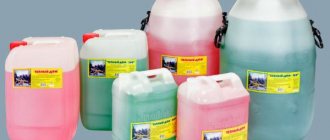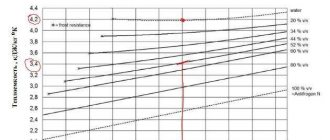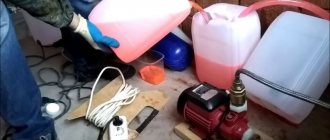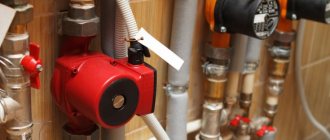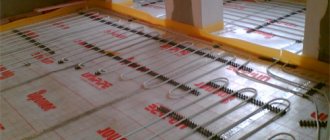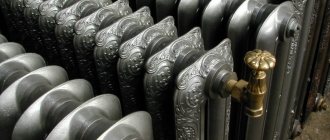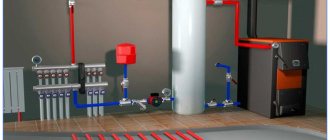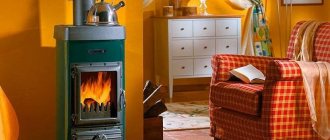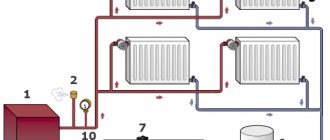The main danger for heating a private home is the possibility of freezing of the heating system. In order to prevent such moments, antifreeze is used. There are many brands of antifreeze for home heating; their composition is similar to antifreeze for cars.
Based on this, many people have a question: can car antifreeze be used at home? Will this lead to irreparable consequences for the heating system and how profitable will it be from a financial point of view? Let's take a closer look at the properties of antifreeze and answer all the questions that arise.
Usually the heating system is filled with water, but if the pipe or battery freezes, it may burst, and when using antifreeze as a filler for the heating system, you should not be afraid of this, since even with a significant drop in temperature, the antifreeze does not crystallize, but becomes a jelly-like consistency.
Should you use antifreeze in your heating system?
Increasingly, not water is poured into the cottage heating system as a coolant, but a high-quality glycol solution containing anti-corrosion and anti-scale additives. When and why should you do this?
Water or antifreeze?
In winter, in the event of an emergency power outage or a drop in gas pressure in the cottage heating system, many of its elements (boiler, radiators, expansion tank, circulation pump, pipes) can be damaged in two or three days by the frozen water in them, the volume of which increases by 9% when moving into ice. If the water is not specially prepared in advance, then additional conditions arise for metal corrosion and scale formation, which impair heat transfer and increase energy costs. To eliminate this phenomenon, antifreeze is used as a coolant instead of water. Antifreeze (from the English freeze - “freeze”) is a liquid with a freezing point below 0°C. It is prohibited to use automotive coolant (coolant according to GOST 28084-89 as amended in 2007) containing nitrites and amines, as well as phosphate and silicate compounds, which form fumes harmful to humans and animals.
In addition, the service life of the coolant is only 2–3 years, and the composition of the additives and their quantity are insufficient to ensure the operation of heating systems. Such a liquid is not designed to be diluted with water at all, especially tap water. You should also be careful with salt water antifreezes such as “Assol”, “Burtas”, etc. Although they are safe for people, they are characterized by high corrosiveness and crystallization of salts when water evaporates. The heating system will quickly become clogged with scale, salt deposits and rust.
Which antifreeze to choose?
Glycol household coolant , which today is used in domestic heating systems half as often as water. It is made from an aqueous solution of ethylene glycol or propylene glycol. Ethylene glycol solution ( monoethylene glycol - MEG, GOST 19710-83 as amended 2006
.) has a negative freezing point: –10°C at 26% solution, –30°C at 45% and –65°C at 65%. We confuse it with coolant (antifreeze). This solution first turns into a jelly-like state, and not with such a change in volume as water, so it will not damage pipes and radiators. However, it should be remembered that MEG is toxic (hazard class 3 according to GOST 12.1.007-76, its maximum permissible concentration is 5 mg/m³) and is corrosive. It is the latter circumstance that forces the use of an aqueous solution of ethylene glycol with a high content of additives, the effect of which is designed for up to 5 years. The mass fraction of additives in the coolant is higher than in automotive antifreeze, reaching 4–5%. Differences in operating conditions necessitate the achievement of other parameters for corrosion protection.
The additive package usually contains a mixture of corrosion inhibitors, inhibitors of scale formation, foaming, swelling and dissolution of heating system sealants, stabilizing and coloring components. Additives also ensure high stability of the coolant and allow it to be diluted with simple tap water (with a hardness of no higher than 5 mg eq/l, and for CHT coolants no higher than 12 mg eq/l) to obtain a working mixture with a low freezing point. But it is worth keeping in mind that too much water when diluting antifreeze at home (by 30% or more) can lead to a change in its properties.
Coolants based on ethylene glycol are fireproof, they have been tested at the Research Institute of Plumbing and the IC "CHIMTEST" of the Russian Chemical Technology University named after. Mendeleev, have a certificate of conformity and a sanitary-epidemiological conclusion, allowing them to be used in residential premises. They are suitable for any boilers, except electrolysis boilers (Galan type), where the coolant is saturated with salts to create a certain electrical resistance, which tightens the requirements for protecting equipment from corrosion and scale.
MEG has a fairly high toxicity, so it is undesirable to use it in double-circuit boilers, when mixing of coolant from the heating circuit into the hot water circuit is possible, as well as in boilers with an open combustion chamber or with an open expansion tank, in which evaporation of the coolant is possible. In this case, it is advisable to prefer a more expensive but environmentally friendly antifreeze based on propylene glycol . It contains technical or food grade propylene glycol, which is absolutely harmless to people. It can be used without restrictions in any heat supply systems.
When purchasing a boiler, be sure to ask whether its manufacturer allows the use of antifreeze, so as not to subsequently lose warranty service for the unit.
Are antifreezes compatible?
During operation, antifreeze may leak and will have to be added to the heating system. It is not recommended to mix any antifreeze without first checking for compatibility. If the chemical bases of their additives are different, this can lead to partial precipitation and, as a consequence, to a decrease in anti-corrosion properties. Thus, the “Warm House” coolant is fully compatible with “Gulf Stream”, the most common in the North-West region, but it is not advisable to mix it with the Dixis Tor coolant, which has phosphate additives. Ideally, glycol antifreeze is best diluted with distilled or demineralized water, which does not contain calcium and magnesium salts, which crystallize when heated and form scale. For example, scale 3 mm thick reduces the heat transfer of the boiler by 25%, and the system will require large energy costs.
There is no need to blame the coolant for deviations from the normal operation of the heating system. For example, the reason for the “airing” of the system should be sought in errors in the design or installation of equipment: in insufficient volume of the expansion tank, the occurrence of a galvanic effect due to the incompatibility of the metals used, incorrectly chosen locations for installing air vents, incorrect settings of the thermostat. At the same time, with prolonged overheating of the system, thermal decomposition of the additives and the glycol itself begins: it becomes dark brown, which indicates an increase in the intensity of metal corrosion, an unpleasant odor appears, and a precipitate forms. Often carbon deposits form on the burners, which causes them to fail.
Some useful tips when using antifreeze
- A fluorescent additive, which will be tinted with the color of the corresponding coolant, will help determine the exact location of the leak in the heating system.
- Since the heat capacity of antifreeze is approximately 15–20% lower than that of water, and it accumulates and releases heat worse, the radiators of the heating system should be chosen more powerful than when using water.
- Galvanized steel pipes cannot be used in a heating system with glycol coolant, as the zinc coating will deteriorate quite quickly.
- A glycol-based coolant designed for –20°C will protect an unused heating system from destruction down to a temperature of –60°C, while a –15°C solution will ensure its safety only down to –23°C.
- The circulation pump should have a capacity of 10% and a pressure of 50–60% more due to the significantly higher viscosity of the glycol coolant compared to water.
- The volume of the expansion tank of the heating system should be 15–20% larger due to the higher coefficient of thermal expansion of the glycol coolant compared to water.
- “Flax with paint” cannot be used as a sealant; in the place of a possible leak, the paint will dissolve in six months. To seal threaded connections, it is necessary to use fum, tangit, and glycol-resistant silicone sealant.
An antifreeze heating system is justified only if it is impossible to take into account the increase in water volume when freezing. If, upon purchase, the boiler manufacturer warns that the warranty will be voided when using antifreeze, ask the technical support service for this equipment how to operate the boiler in the Russian winter with frequent outages of electricity and gas. If they recommend purchasing a generator with automatic switching, think about it - maybe you should abandon such a boiler?
Switching to antifreeze instead of water will tighten the rules for operating the heating system for its long and reliable operation. Thus, you should not pour antifreeze into a system that has been operating on water for a long time; its penetrating ability is much higher, which can cause leaks that did not exist before
Subscribe to our Yandex Zen channel so you don't miss anything!
Diesel boiler
Diesel units are autonomous equipment that runs on diesel fuel - diesel fuel. This boiler requires electricity to operate. The diesel boiler is equipped with a fan burner, which functions so that when fuel is atomized, it mixes with air and combustion becomes more intense.
Diesel boilers from modern manufacturers have a removable burner design and the equipment can be converted to gas. To do this, install a gas burner. For a dacha, this is quite convenient, since if a gas main appears in the village, you can easily redo the system. A diesel autonomous boiler operates with a water system, during the installation of which it is better to rely on a coolant in the form of antifreeze.
But the disadvantages of this equipment include the high cost of fuel. Considering the option of heating a dacha, we can conclude that the boiler will not burn constantly, and accordingly the costs will be small. If necessary, its installation is carried out by specialists on a turnkey basis.
Do you think that such work can only be entrusted to professionals?
Of course, installing a wood-burning stove in the house or setting up a fireplace in the countryside seems much easier. However, spend a few evenings studying the theoretical part, and you will be surprised to notice that making such heating yourself is quite possible. An additional bonus for you will be that literally every centimeter will be familiar to you inside the water heating system, and if necessary, you can easily replace failed parts with your own hands. Heating using liquid circulating in the system is recognized as the most beneficial for low-rise buildings. Let's look at how to make water heating, what materials and equipment will be needed, and how to install it correctly.
What is required for installation?
- boiler or oven;
- pipes;
- radiators;
- expansion tank;
- standard set of installation tools.
Before purchasing all this, it is worth understanding how water heating works and developing a plan for heating your home or cottage. The diagram looks like this: the coolant heated by the boiler (it can be water or a special mixture) enters the radiators, in which it cools, giving off heat to the room. Schematic diagram of water heating
The cool coolant returns to the boiler, where it heats up again. Due to such continuous cycles, your room is heated. Water heating systems are divided into natural and forced. By choosing the first option, you will be independent of electricity to operate the pump. The movement of liquid through the system occurs due to the laws of physics - the hot coolant expands and rushes upward, and, having lowered the temperature, it decreases in volume and falls down. With natural circulation, it is necessary to maintain a slope of all pipes of at least 2 degrees (ideally 3-5), avoid pipes of small cross-section (40 mm pipes are suitable for the riser, pipes with a cross-section of 22-24 mm can be used for supplying the heating sections).
Natural circulation has serious disadvantages: internal wiring is not allowed - when the water level in the expansion tank decreases, the movement of liquid is difficult. It is also applicable only in cases where the distance along the pipes between the boiler and the farthest radiator does not exceed 20 meters, and the area of the heated room is less than 150 sq.m.
As you can see, natural circulation with its limitations is not always applicable. In a forced system, the flow of coolant is regulated by a circulation pump. Of course, purchasing a pump is an additional financial expense upon purchase and an addition to monthly electricity bills, but look at the advantages - you are spared the need to clearly check the angle of inclination, there is no need to observe a wide cross-section of risers, it is possible to make internal pipe routing and connect , for example, “warm floor”.
Two-pipe heating system
There are two water heating systems - single-circuit and double-circuit. Installation of the first option involves heating only. The second option, in addition to heating, provides the room with hot water and is very convenient in the country, in cases where it is not planned to install a separate source of warm water.
Selecting a heating device
Water heating can be carried out using a gas, electric or solid fuel boiler. If gas is supplied in your area, heating with a gas boiler will be convenient and least expensive. In the absence of gas, electricity and traditional fuels - wood, coal, pellets - can be considered as a heating source. The advantage of a solid fuel stove over an electric boiler is obvious - the cost of operation. The use of electric heating in a dacha is fully justified if you are not there every day in cold weather and, accordingly, do not have the opportunity to control daily fuel or gas loads.
Water heating is not practical for a small private house, since it is more practical to simply hang electric radiators.
And for a large house, using electricity to heat the coolant may be incompatible with the simultaneous operation of other electrical appliances.
Car antifreeze in the heating system. Is it possible?
We are often asked questions by visitors who decide to buy a heated towel rail for an electric heating element, whether it is possible to pour car antifreeze or car antifreeze into the heating system.
it is ABSOLUTELY IMPOSSIBLE to pour car antifreeze or antifreeze into a heating system with heating elements You can only use special glycol-based liquids, for example “FRITERM-30”.
The best coolant in an electric stainless steel heated towel rail is distilled water, provided there is no exposure to negative temperatures.
Why? The fact is that heating elements get very hot during operation, having a temperature of approximately 300 degrees. And around the walls of the heating elements there is intense evaporation of glycerin, which is part of the antifreeze (glycerin is nothing more than the simplest molecule of alcohol). And as you know, any liquid has the ability to turn into steam and gas. So, glycerin, evaporating into gas, pulls along with it hydrogen, which forms an explosive mixture - gas synthesis. This gas is harmful to health and explosive.
But what to do if you have already filled in antifreeze or there is simply no other way out to prevent the pipes from bursting from frozen water? Then the main task is to prevent synthesis gas from accumulating, which implies the installation and constant monitoring of the serviceability of automatic air vents (automatic Mayevsky Crane). They look like the photo below (variations are possible).
Also, these gases should not penetrate into living spaces. If the heating system has an open expansion tank installed in the attic of the house, then it must be taken outside, because synthesis gas is heavier than air and will penetrate into the living room when evaporating.
The use of antifreeze for an electric heating boiler requires fulfillment of certain requirements. First of all, it should be remembered that the ideal option for the functioning of a heating structure with an antifreeze substance will be only if a powerful circulation pump, a more efficient boiler is used, as well as special seals that are ready to withstand not only water, but also aqueous solutions of glycols.
In addition, after several years of operation it will be necessary to fully monitor the operation of the installation and, possibly, adjust the density of the antifreeze to achieve sufficient efficiency of the structure. In turn, if antifreeze concentrate is used for heating systems of electric boilers, when diluting it with water, it is important to strictly follow the proportions specified in the instructions, since their violation can lead to serious malfunctions in the operation of the equipment.
If you compare antifreeze with water, in addition to the advantages, you can identify a number of disadvantages:
- increased viscosity requires heating equipment to be equipped with a powerful circulation pump;
- 15% lower heat capacity, therefore, the amount of heat given off is less;
- Detachable connections should be sealed more carefully;
- radiators are required that are 50% larger in volume than their water counterparts;
- a closed expansion tank is required, since increased expansion occurs during heating;
- The toxicity of a substance (for example, ethylene glycol) in antifreeze requires its use in single-circuit boilers.
Solid fuel boiler
The fuel used in this installation is firewood, coal, coke, and peat briquettes. Heating using a solid fuel boiler (Fig. 4) is autonomous heating for a summer house. The advantage of this equipment is the low cost and distribution of fuel. This is a way out of a situation when the village has problems with electricity and there is no gas supply.
Rice. 4 Installation of a solid fuel unit at the dacha
New models of solid fuel autonomous boilers have many advantages. They work with any coolant (antifreeze, water) and maintain the temperature in the house for a long time thanks to a special valve and sensor. This boiler has more time between fuel loads. Heating a dacha with wood is a cheap and effective option.
In this case, correct installation of the chimney is very important; its height is indicated in the instructions for the boiler model. Installation can be done independently or on a turnkey basis.
Antifreeze for the heating system of a private house - properties and features.
Many of my friends are sincerely perplexed when they hear that antifreeze is quite often used as a coolant in country houses. Currently, you can find quite a few types of antifreeze on the market - they all differ in their main component. In particular, you can find on sale antifreeze for pipes and other elements in the heating system, the main part of which is a saline or alcohol-containing solution, or purified propylene glycol.
Ethylene glycol products
Ethylene glycol has a slightly oily texture, comes in several colors, and is odorless. The disadvantage of this type of antifreeze is its high toxicity. Avoid direct inhalation or contact with unprotected skin. This can lead to serious consequences, including death.
For this reason, its use for a heating system is limited - it cannot be used if there is a risk that the coolant may get into the hot water supply pipeline.
A red dye is added to antifreeze to alert people to the properties of the product and allow them to instantly see the leak. Such antifreezes are used up to temperatures of minus 65 degrees. It is noteworthy that ethylene glycol-based antifreezes are prohibited for use in some countries.
Antifreeze properties
It is known to almost everyone as an “anti-freeze liquid”, which is often used in cars. By its name you can understand that this mixture has one useful advantage - it is almost impossible to turn into ice, since the mixture does not freeze. Or rather, it freezes, but only when the minimum temperature is reached. Modern antifreezes can easily withstand even -55 degrees Celsius, freezing only when the temperature reaches -68.
Antifreeze for heating systems freezes only when the temperature reaches an even lower value. Naturally, the main reason for such resistance to cold is the maximum concentration of the active substance in the mixture. Also, if you add water to the mixture, you can change the freezing point.
Benefits of using antifreeze
- Antifreeze is effective and, in general, makes it possible to effectively protect steel parts of the structure from the effects of corrosion;
- Antifreezes are able to effectively dissolve and remove sediment;
They can also prevent the destruction of internal metal parts in pipes and boilers, including plastic ceilings.
From this we can conclude that the use of high-quality antifreeze in pipes is quite convenient, because such a mixture can significantly increase the service life of most elements in boiler equipment.
Technical certificate
It is also important to take into account that the technical description for such equipment usually indicates only those parts and elements that are not affected by such a liquid. Naturally, it is also important to remember that often the technical documentation for a heating boiler and similar equipment contains a list of coolants used. Also, in most cases, the passport for heating equipment indicates “water can be used as a coolant.” But still, the majority of buyers either do not look at the technical documentation data at all (which they later regret very much), or look there only after the purchase.
How to change the coolant in a car yourself at home?
Most drivers never change the coolant in their cars, and some are not even aware of its purpose. For those, let's reveal a little secret: coolant (antifreeze, coolant, etc.) is a substance that helps prevent your car's engine from overheating. If the coolant does not cope with the task, then your car will overheat and the engine will be damaged. And all this is due to untimely vehicle maintenance! In addition, old coolant can create corrosion in the car's radiator system, which again means extra costs for vehicle repairs. To prevent the troubles described above, you should change the coolant approximately every two years. Experts from our online service Zap will tell you how to do this at home, on your own.
Pouring the finished mixture
When pouring the finished mixture from the concentrate, you must remember that it is carried out only with a cold engine. In addition, the fluid level should be monitored. After filling the liquid, you need to release any air pockets formed during the process. To do this, remove the filler cap and start the engine. In this position, it should work until all air bubbles disappear.
Making coolant from concentrate is not a complicated procedure. The main thing is to follow safety precautions, the recommendations indicated by the manufacturer on the canister, and the proportions.
Negative effects of antifreeze
If you want to configure your heating system, then you should take this parameter into account. Many people still think that such a mixture turns into ice when heating a cottage at an ambient temperature that is several times lower than the freezing point of the same water. However, in this case, almost no one pays attention to the other properties of the antifreeze that will have to be used in pipes. And these characteristics are very different from the properties of water. Keep in mind that the level of heat capacity (and no matter what it is made of - with the addition of what substances) is much lower when compared with plain water - by 10 percent or more.
In addition, all new types of antifreeze have a significant increase in volume during use - this increase will be at least 60%.
Bake
The most popular method of heating is heating the dacha with wood. Often the stove (Fig. 1) is installed in houses for seasonal holidays. The main advantages of such heating of a dacha can be noted:
- Low cash costs for installation, fuel and maintenance. The fuel is usually wood.
- It makes no difference how long the oven has not been in operation, it is always ready for use.
- Does not depend on electricity.
- Versatility, that is, with its help you can not only heat the cottage, but also cook food.
The main disadvantage of the stove is that it is not automated in any way; it is lit and serviced entirely manually.
Rice. 1 Installation of a wood-burning stove in the country
Physical characteristics of water and properties of modern antifreezes
The second most important disadvantage of antifreeze is its high viscosity index - this indicator is several times higher than that of water.
The properties of antifreeze listed above tell us that even high-quality antifreeze in a cooling/heating system can be harmful. In reality, this is not such a good coolant if you thought otherwise at the beginning, since in addition to the above parameters, the boiling point and the thermal conductivity of this coolant will also differ significantly.
Important: when setting up and engineering a heating system, the main thing is the characteristics of the water. That's why, if you want to adjust your heating and use antifreeze in your home, there are a lot of different changes worth making at the very beginning. It is also important to buy a high-quality expansion tank for antifreeze storage in advance. Another important thing in this matter will be the need to increase the power rating of the radiators in the house. The listed nuances make the heating system in the house using antifreeze quite expensive.
Keep in mind that any modern system of pipes and boilers, where antifreeze is planned to be used as the main coolant, will be sold at a much higher cost than the same system, but using plain water.
How to determine what is flooded?
It will not be possible to check and recognize using color what is in the car. Antifreeze is always colored blue. But modern antifreezes are also available in blue.
If you don’t know what’s in the car, you can determine the type of consumables based on several factors:
- Smell and taste. Antifreezes are usually odorless, and if you touch the liquid, it will be more oily, unlike traditional antifreeze.
- Determining the type of liquid can be done by diagnosing the compatibility of the refrigerant with ordinary water. You need to take a little substance from the expansion tank and mix it with tap water in a 1:1 ratio. Afterwards, the container with the refrigerant is placed in the freezer for about one hour. If, as a result, the liquids separate, the mixed substance becomes cloudy and sediment forms at the bottom, then you use Antifreeze. If high-quality antifreeze is poured into the cooling system of your car, then such problems will not arise.
- Another factor is resistance to negative low temperatures. Pour a small amount of refrigerant into a separate bottle and place it in the freezer. When using Antifreeze, the liquid will quickly freeze, but if a good refrigerant is added, this will not happen.
- Using a hydrometer, you can diagnose the density indicator of a substance. The test should be carried out at an air temperature of 20 degrees. With this condition, the refrigerant density parameter should be about 1.073-1.079 g/cm3. If so, then you are using antifreeze.
For diagnosis, you can resort to the old “old-fashioned” method:
- You will need a plate or other metal device. You will also need a rubber product, for example, a piece of hose from the cooling system.
- Take some fluid from the reservoir under the hood of your car. You need to pour it into a jar or bottle, where you should also place a plate and a piece of hose.
- After 20 minutes, look at the result. Russian-made consumables create a protective layer on all components of the cooling system. Accordingly, you will see a barely noticeable film on both the plate and the piece of hose. If the metal is corroded, and a film has formed only where rust is present, then you use antifreeze. Remove the products from the container and check them by touch.
How can you tell what kind of antifreeze is in your car from the factory?
To understand what brand of refrigerant to add to the refrigeration system, you need to know what is initially added from the factory. You won't be able to determine this on your own. An accurate conclusion can only be given by the results of laboratory tests. Alternatively, you can contact your dealer or read the service manual. It indicates which standard of refrigerant should be used.
You can learn about mixing refrigerants and the results from the video filmed by the Avto-Blogger.ru channel.
Is it possible to fill something in if you don’t know?
If the situation is urgent, for example, while driving you had to stop because the engine overheated, then you can also pour water into the cooling system. If this happens during the cold season, we recommend that you do not ride on water for a long time, but rather drive to the nearest service station or garage to solve the problem. Even when adding fluid in the warm season, after using the car, the cooling system is flushed. In cold weather, water will quickly freeze, and it has the property of expansion, so freezing will damage the expansion tank and pipes.
It is possible to mix only those refrigerants that correspond to each other in composition and standard. Mixing antifreeze and antifreeze is not allowed. This will lead to a chemical reaction, as a result of which the liquid will lose its properties and will not be able to perform its duties. Precipitates form in the cooling system, which prevents the normal circulation of consumables through the lines. Due to the loss of properties, corrosion will appear on the internal parts of the radiator device, which over time will lead to serious damage to the unit.
If you had to mix Antifreeze with antifreeze, then do not delay the replacement process. It is necessary to drain consumables. When changing, the engine is flushed, and the procedure is repeated several times. This is done until clean water without deposits or traces of scale begins to come out of the cooling system. Then we can assume that the cleaning was completed successfully. For washing it is allowed to use special means. When filling, take into account the engine specifications and the manufacturer's recommendations for the use of antifreeze.
Cottage heating system using ethylene glycol
The cottage heating system in the form of ethylene glycol is used quite often in the north and in the middle zone. However, such filling (using ethylene glycol) is dangerous for metal pipes and can destroy them.
It is important to remember that this chemical liquid can react noticeably to increases in temperature in the pipeline. And if at some point the temperature of ethylene glycol rises to a dangerous value and reaches its highest point, its decomposition will occur. As a result, a lot of acids and strong particles are formed, which can damage the entire heating system.
Important: any acids flowing in the pipes, if there is a noticeable increase in temperature, can damage it, causing premature release of the pipes and rapid corrosion. In addition, such acids can significantly reduce the operating time of carbon cells, which will ultimately damage the batteries and create a leak.
- Naturally, many readers will say that after you have filled in the antifreeze, all you need to do is monitor the operation of the system from time to time and adjust it, trying to prevent excessive temperature rises in the pipes. But are you able to carry out this control constantly? Most likely you won't succeed. This is why companies that produce heating systems warn their customers against adding antifreeze. Because, having taken into account the sufficient list of positive qualities of this coolant, some do not take into account many of its disadvantages - and then are forced to pay for their arrogance.
- Another negative quality of antifreeze, which almost no one knows about, is its ultra-high fluidity, which can lead to leaks in the home heating system. Such leaks can occur when the pipes in the house are not working or the pipes are cold. In this case, the possibility of expansion of the steel structures of the system increases - which allows antifreeze to leak out in some places.
How to choose antifreeze for a country house heating system
First, let’s immediately dot the i’s and answer the question: “Is it possible to pour antifreeze into the heating system?” If there is a possibility that the temperature in the premises will drop below 0 0 C, then it MUST be filled. There is no alternative! Water, as a coolant, is unsuitable in this case, since at subzero temperatures it freezes, while expanding and bursting the pipes. If sub-zero temperatures are excluded, the question: “Water or antifreeze in the heating system” should be clearly resolved in favor of water. It is much cheaper and has a 20-30% greater heat capacity. Accordingly, the area of radiators or convectors can be reduced by the same amount.
How to protect your car from freezing water in the engine. Useful tips
Unfortunately, not every car enthusiast can afford to keep their car in a warm garage. If you have to leave your vehicle in an open place, you should follow certain instructions to protect the car from hypothermia:
By draining the water after turning off the engine, you can protect yourself from freezing. However, there are some difficulties here, such as the impossibility of completely removing all the fluid from the engine, caused by the technical features of the car. Freezing, the remaining water forms impassable plugs, making it difficult to subsequently refill the cooling system; A heat insulator attached to the back of the hood reduces the possibility of damage to the unit. Protecting the radiator with a special apron will also help. You can protect the engine from freezing during minor frosts during a short overnight stop by insulating it with old blankets or jackets
However, it should be remembered that the described precaution lasts only for a short time, and after a few days you risk losing the motor; When choosing a parking spot, try to consider the direction of the wind. By protecting the radiator from direct air flow, you can minimize the risk of engine freezing; It is not recommended to show inappropriate savings
Just one liter of antifreeze added to the cooling system will help avoid problems associated with major overhauls of the power unit; Periodic warming up of the engine will protect against the appearance of ice even at −10 0 C. This method causes great inconvenience, since it requires visiting the car every hour.
Antifreeze for heating
For country houses, one of three types of these liquids (that is, non-freezing at certain negative temperatures) made on the basis of:
Let's look at the features of each of them to make the right choice.
Ethylene glycol
Oily, colorless and odorless liquid. The crystallization temperature is minus 66 0 C. It is not used in its pure form for heating a house, but is diluted with water, plus additives are added. All coolants based on it are red.
- low price - about 80 rubles. for 1 kg;
- chemical neutrality to equipment (radiators, boiler);
- long service life - on average about 8 seasons.
A critical drawback is the toxicity of both the liquid itself and its vapors. Therefore, it is prohibited to be used in open heating systems (open expansion tank, no circulation pump) and is highly undesirable to use in double-circuit boilers. There is a high probability that toxic liquid will enter the hot water supply. This significant drawback is aggravated by the fact that ethylene glycol is a very fluid liquid and can leak out even with a microscopic leak. Therefore, a fluorescent pigment is added to it, which will indicate the location of the leak.
Propylene glycol
Absolutely safe substance for humans. It is even used in the food and pharmaceutical industries. Freezing temperature minus 60 0. It is also diluted with water and additives are added to it. The main disadvantage compared to ethylene glycol is that the price is on average 2 times higher. All coolants based on it are painted green.
Glycerol
In terms of use in home heating, glycerin is intermediate between ethylene glycol and propylene glycol. It is safe for humans, more expensive than ethylene glycol, but cheaper than propylene glycol. Does not tolerate overheating well and corrodes gaskets. The most valuable quality, glycerin, decreases in volume when frozen, so it does not destroy pipes. And when thawed, it completely restores its properties. Painted blue.
What is the best antifreeze for the heating system of a country house?
From the point of view of safety and equipment service life, the best antifreeze for home heating is propylene glycol. Glycerin is more accessible, and even if it freezes, it will not damage the equipment. But he is “not indifferent” to rubber gaskets. Ethylene glycol can be chosen if you definitely have a single-circuit boiler and a closed heating system, the reliability of which you are absolutely sure of. Or maybe it’s better to pay an extra couple of thousand rubles and sleep peacefully?
Below are the main characteristics of the most popular non-freezing coolants.
Possibility of dilution with water
Warm House – Eco
ANTIFROST based on glycerin
If you find it difficult to choose (and not only the comfort in your home, but also the safety and cost of heating operation depends on its correctness), contact a specialist. They know the market for such liquids very well and will recommend the best option.
Other ways to heat a dacha without electricity
There are other methods of autonomous heating. First of all, these are traditional brick stoves and potbelly stoves. And if the former also require the participation of a designer and a master stove-maker, then installing the latter is not difficult. The main thing is to remove the chimney and protect it from contact with the ceilings with non-combustible material.
Another relatively inexpensive and easily installed heating method for a summer house is a diesel stove. The operating principle is to burn liquid fuel. The cost of such fuel is usually not high, and there are no special requirements for its storage. You just need to prevent fuel oil from spilling, as this will harm the surrounding environment. Diesel fuel stoves can be made independently. Having a simple design, they are able to quickly heat a small room and are therefore a suitable option for a summer residence.
Features of heating with antifreeze in a private house
- It is necessary to increase the number of battery sections by approximately 20-30%, since the heat capacity of such a coolant is the same percentage lower than that of water.
- A larger expansion tank is required. For example, if the volume filled with coolant is 800 liters, then a 100 liter expansion tank is required for water, and 150 liters for ethylene glycol or propylene glycol. However, with small volumes (for standard apartments) - 100 -120 liters, the required tank capacity increases from 25 to 30 liters.
- If glycerin is used, rubber gaskets must be replaced with Teflon or paronite ones.

